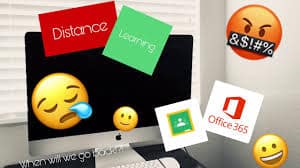Waiting for Godot
Education changed my life. As a student at the Harvard Graduate School of Education, I remember the first time I went to the Gutman library on campus to take the elevator to the third floor to meet with my advisor at the time, the well-respected and beloved, Dr. Charles V. Willie. I pushed the button to call the elevator to the ground level and stood there by myself with excitement and anxiousness of meeting Dr. Willie for the first time.
As minutes started to go by, more and more students joined me on the first-floor entrance waiting for the elevator when what appeared to be a doctoral student rushed by us to take the stairs and said comically as he ascended to the next floor;
“Are you guys waiting for Godot? Good luck with that one?”
Five minutes went by and other students started taking the stairs and then I said to myself; “Who is Godot?” As what seemed like ten minutes approached, I decided to just take the stairs too. After my first meeting with Dr. Willie, I went back down to the first floor of the library to study and do a quick search on the computer about Godot. Waiting for Godot is a play in which two characters wait for the arrival of someone named Godot who never arrives. The statement was a metaphor of the experience students at the ed school have waiting for an elevator that appears to never arrive.
COVID-19 Environment
I have never been through a pandemic before. Everyone around the world is going through something no one has the answers to and many of us have grown up in a society that is quick with answers and solutions; experts in almost every field you can imagine, yet, in today’s “temporary normal” we don’t have any experts-per-say to help us navigate through life during these unprecedented times. One sector where this has been glaringly more obvious than others is within the K-12 education environment across our country.
Under the COVID-19 crisis, the educational veil has been pulled back and it did not take long to realize that even though school districts tout technological innovations and advances and 1:1 devices within the classrooms, we still have a long way to go to providing a quality and equitable distance learning environment experience for students and parents. The most passionate and smartest minds in America with three additional letters added to their last names behind closed doors are left scratching their heads with a blank look on their faces. We all are! What this moment reveals is a deep-seated need to work together, to struggle together, and figure this out together as we have never collaborated before. The times we are in demand for each of us to live and act outside our comfort zones.
Educational institutions often function in silos – public, charter, private, religious, preschool, elementary, high school, but with the setting of the sun post daylight savings time, COVID-19 shattered those walls. Many students and parents are looking to their teachers, principals are looking to their district leaders, district leaders are looking to their county and state, and states are looking to the federal government for answers and direction.
Many school districts, in most cases because of the sudden onslaught pandemic have had to build the non-social distance learning plane in the air while flying. Right now, many parents are waiting for Godot when it comes to school districts helping families figure out what to do next, but, in the back of our minds, we know that Godot is not coming. We can and we must figure this out on our own – alone, but, together. This is not to say that school districts are not doing their part. They simply have been placed in an awkward position of trying to get students together while also keeping them apart with limited resources and for some teachers, distance learning has been a challenge.
In the state where I live, the California Governor Gavin Newsom addressed the million-dollar question on every parent’s mind; When will school reopen? The governor aimed to reassure parents like me that stay-at-home and social distancing orders “will not be a permanent state.” He then went on to explain that until state officials feel confident that the rate of new infections is falling and health care infrastructure has improved, restrictions on most normal activities – including going to school, will continue for not weeks but months (Koening, 2020).
Distance Learning As A Parent
As the father of four children ages 17, 15, 12, and 9, my anxiety levels are high with the challenges in front of us with the fact that my children will most likely not return back to school for the rest of the school year. Even worse is the pain I feel for my senior in high school who will never experience her senior prom, grad night, or putting on her high school cap and gown and walking down the aisles of supportive family and friends to pomp and circumstance during her high school graduation. Wow, as a parent my heart breaks for our students during this pandemic.
The roll-out of distance learning has been just as painful having four children, one in elementary, one in middle, and two in high school. My older three children are independent learners and seemed to adjust somewhat to their new distance learning schedule but supporting my third grader who is still a dependent learner is more of a challenge. The information and process from the teacher was last minute and the first virtual call with the teacher lasted no more than 20 minutes and left my daughter walking into my home office in tears. Needless to say, her first distance learning experience was a bust. When I asked her what happened she said sobbing;
“Everyone kept talking over me. I could not hear the teacher and what she was saying. I wanted her to teach me something but it was just a check-in call.”
I did not know what to tell her. My first response was to send the teacher an email about the experience; then send an email to the school principal, and then to the Superintendent of the district. As I started to put the emails together to the right of me was my facemask and the blue latex gloves I wear when I have to make a run to the grocery store and it hit me – we are going through a worldwide pandemic and for all intents and purposes what use to be commonplace is no longer. At that moment I decided to let my anger and frustration go and decided to reach out to other parents and educators regarding their experiences. Most importantly, I told my daughter not to worry about it and that we would get through this together and just do what we can under the circumstances.
In a recent article I read, the authors (Flaccus and Gecker, 2020) posed this survey question to parents: Is distance learning working for your family? Out of a total of 792 parents who took the survey, only 24% said; “Yes”, 34% said; “No”, and 42% said; “Trying their best.” I believe parents are trying their best and willing to do whatever they can for their children to be successful with distance learning. To provide a qualitative perspective, I reached out on Facebook and asked a similar question and below is a sample of the messages I received in no particular order:
“So far, for my third grader, it’s been OK. It’s just hard for me to consistently keep him on task when I have work to do at the same time. But, I do like that I can personally see what he knows/don’t know, and can help him one on one when needed.” – A mother in Southern California.
“My high schooler is flourishing— she is absolutely missing the social aspect of school but appreciates the independent learning and ability to set her own schedule. My elementary school students are struggling and so am I! They appreciate the structure of the classroom schedule and learning outside the home and I’m not able to recreate that as much as I’d like to— nor do I have the time or extra brain space while trying to work from home. Distance learning is very “piecemeal” and there are multiple platforms with different logins and setups per teacher and it has been stressful on everyone involved. I feel like the teachers are doing their very best and are super supportive. There have been frustrations and tears from all involved.” – A mother in Florida.
“I am a preschool teacher teaching remotely is very hard especially when I work with low-income families who may not have access to WiFi or computer. They may have a phone but might not have enough data, to join a Zoom classroom or watch a video of me teaching a lesson. It is hard to hear them all at once on zoom or understand when everyone else is talking. Sure there some connection still there but not like a had in the classroom. I am saddened and missing my kiddos and my classroom.” -An early childhood educator in Maine.
“I can write more when I get on the computer. But have a 1st grader, we just finished week 2 of our distance learning program. It’s been a mixed bag. I still have to actively work 9-5:30 from home and my husband is an essential employee so he isn’t home. My 7-year old basically has to fend for herself and though the first week was a mess. Last week went a lot smoother and there were no tears (from either of us).” – A mother in Oakland, California.
“Our district has been sending enrichment activities and it was hard to get the kids to really do them since they weren’t “required”. This past week, on Thursday and Friday, they officially started remote learning which is required for a pass/fail grade at the end of the quarter. My senior in high school does her work. She’s well organized and can manage all the emails being sent to her, thankfully. She’s responsible and works hard, but really misses these last few weeks as a senior. My 6th grader who is also responsible and does his required work feels slightly overwhelmed at keeping track of what is due and when. He usually enjoys school but with this way of learning, there’s a huge disconnect. He does enjoy meeting up on zoom and seeing his teachers and friends. That’s the highlight of it all. I find distance learning slightly overwhelming as both a parent and teacher. As a parent, making sure all the emails are being checked and nothing is getting missed- on top of my own work and schedules being managed and sent out – can be a lot. I work with English language learners and some of these families are really hurting. We were able to get chrome books out to them, but many don’t have the language or knowledge on how to help their children. Many stay disconnected and it’s tough to reach them. There is an inequity to distance learning for this part of our population.” – A mother and a teacher in Massachusetts.
In another article in The Atlantic, the frustration of parents is growing as more families across the country enter less than a month of distance learning. With a plethora of learning apps, video meet-ups, and e-mailed assignments that makeup pandemic homeschooling. The author believes;
“Some frustrated and exhausted parents are choosing to disconnect entirely for the rest of the academic year. Others are trying to keep up while working long hours and have resorted to cramming all their children’s schoolwork into the weekends or are taking days off work to help their kids complete a week’s worth of assignments in a day” (Mandel, 2020).
The majority of parents I spoke to are college-educated and come from two-parent working households. They represent the 42% trying to put in the effort or their experience with distance learning has been mixed. However, a deeper concern is for the single-parent who is an essential worker who is struggling to find child care let alone the time to focus on distance learning right now for their child(ren). What about those students who have been confined to a home environment where they are silently confronted with abuse and neglect, or, our most vulnerable student populations – foster care and homeless youth? Some children have parents who don’t speak English as a first language, but who could provide instruction much more easily in their native languages.
Some families have two working parents trying to fit in school with their kids. Some families have an out-of-work parent because of the financial crisis that has resulted from this pandemic. One-size-fits-all education barely works in a classroom, but it is completely inconceivable for students and their families in crisis (Mandel, 2020).
So, What’s A Parent To Do
The next few months will radically change how parents think about the education of their children. For the time being, they are responsible for it. That’s why it’s time for parents to take charge of your child’s schooling. Parents, not teachers or administrators, are the ones in the trenches—and so parents, not teachers or administrators, need to set the schedule and priorities (Mandel, 2020). Below are four tips parents can start doing right away to reduce the unwanted stress and frustration caused by distance learning.
- Remember, your child comes first. Focus on what you feel is best for you and your child during this time. Together come up with your distance learning plan and schedule that works best for both of you first then work within the parameters set by your school/teacher. When I realized that I was in the driver’s seat and not the school system, educating my daughter during this time got a whole lot easier.
- Be the number one advocate for your child. Provide direct and constant feedback to your child’s teacher on what’s working and what’s not. Reach out to your school’s principal as well and provide recommendations for enhancements. In certain situations where you do not feel as if your voice or your student’s agency is not heard or respected reach out to the superintendent or school board trustees.
- Practice self-care for you and your child. The old adage it is hard to take care of others if you do not take care of yourself comes to mind here. Give your mind, body, and soul permission to relax, permission to heal, and permission to just be. It does not have to be over a long period of time but daily practice should be a prerequisite.
- Do something for another family in need. In a moment of crisis serving others makes a big difference. Reach out to help other parents who need additional resources and support. The help does not have to be related to just distance learning. For instance, if you know of a family really struggling during this time offer to bring them groceries, cook a meal or two for them, or offer financial support for their monthly bills if you have the financial means. Offer advice and share what you are doing to get through this time, but, most importantly, offer to be a listening ear to what they are going through.
In conclusion, students will not be going back to school this calendar year; school districts have already conceded as much. Parents will be in this situation not just for a few weeks, but for a few months. Schools still play a constructive role, even if they aren’t holding online classes for students stuck in their homes. Instead of spending time on developing online lessons and hours per week on zoom calls or Microsoft Teams, teachers should work together more with parents to differentiate distance learning outcomes for the remainder of the school year with parents directly. Most parents (including me) have never been asked for their input or feedback on what’s best for their child(ren) during a distance learning shelter-in-place environment (Mandel, 2020).
If you are a parent with children we would like to hear from you regarding distance learning and how it is working or not working for you. Let’s connect and please feel free to share this article throughout your network.




